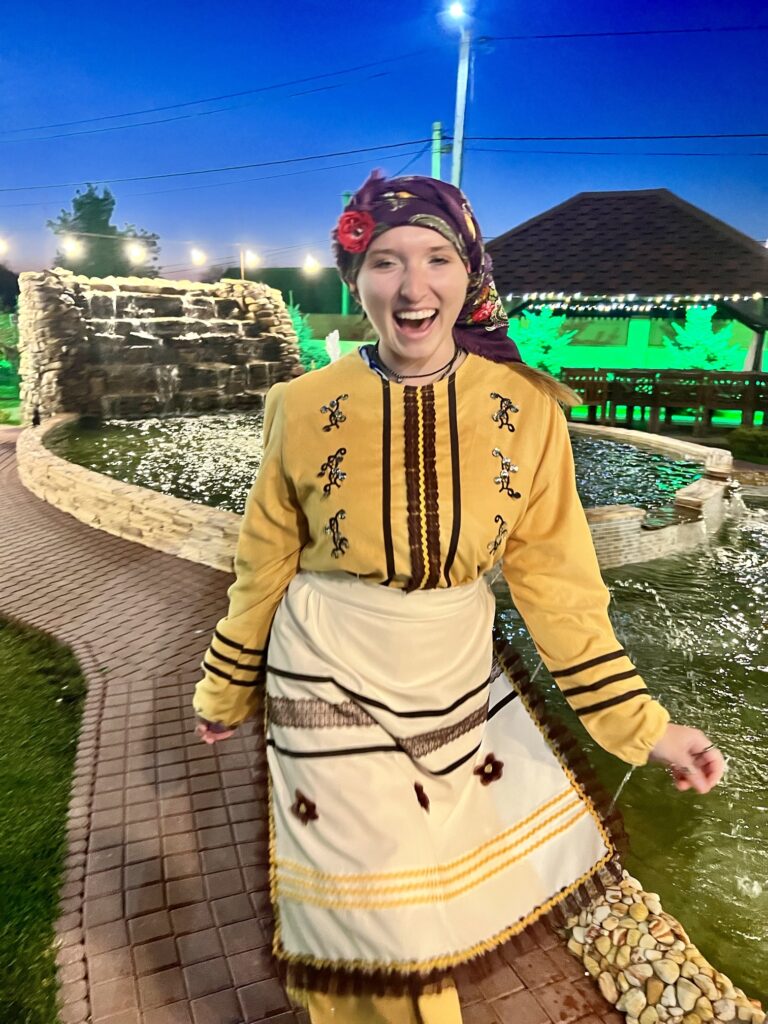
What Food to Try in Morocco: Tastes of Morocco
 April 25
April 25
 13 min read
13 min read
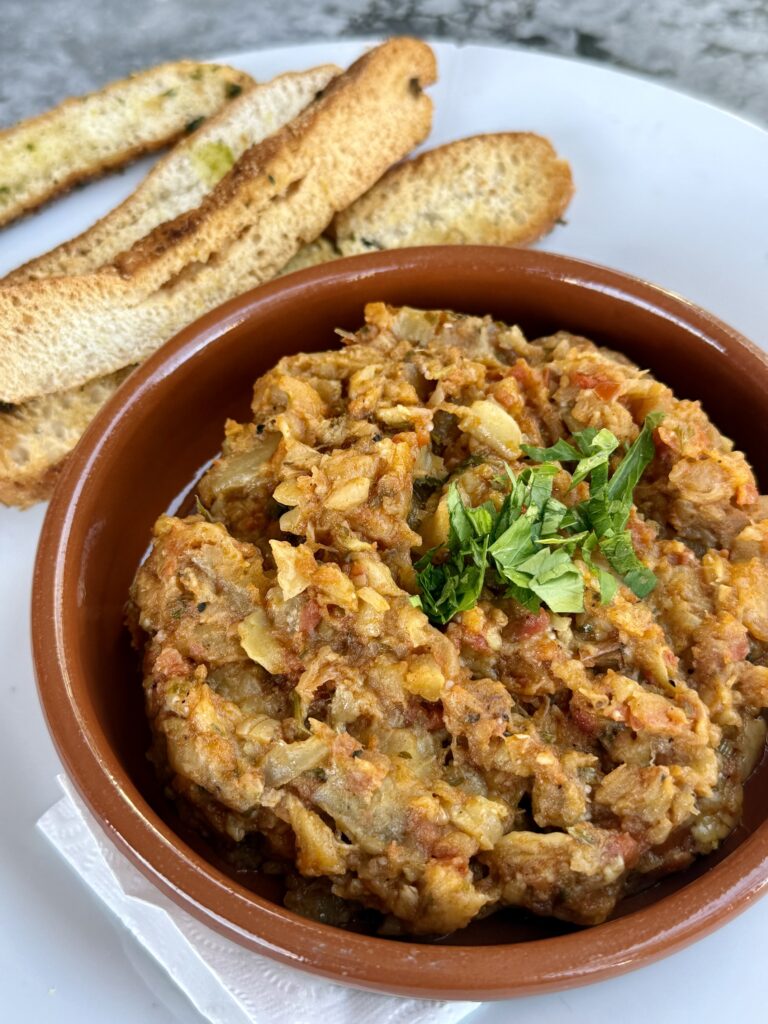
What Food to Try in Morocco- Key Highlights
- Discover what food to try in Morocco! Moroccan cuisine is a captivating blend of Arabic, Andalusian, and Berber influences, resulting in a unique and flavorful culinary experience.
- From aromatic tagines to fluffy couscous and flavorful street food, Morocco offers an abundance of culinary delights for every palate.
- Indulge in traditional dishes such as tagine, couscous, pastilla, and mechoui, each prepared with a medley of aromatic spices and fresh ingredients.
- Explore the vibrant street food scene, savoring tempting treats like maakouda, sfenj, and brochettes, bursting with local flavors.
- Complete your culinary journey with a cup of refreshing mint tea, a symbol of Moroccan hospitality, or indulge in sweet treats like chebakia.
Introduction
Moroccan cuisine is a wonderful mix of tastes, influenced by many cultures over the years. In busy markets and small restaurants in tourist areas, the smell of tasty spices and slow-cooked meals fills the air. This invites visitors to enjoy a food journey. Discovering traditional Moroccan dishes is important for experiencing the rich history and lively culture of the country. Learn what food to try in Morocco during your visit!
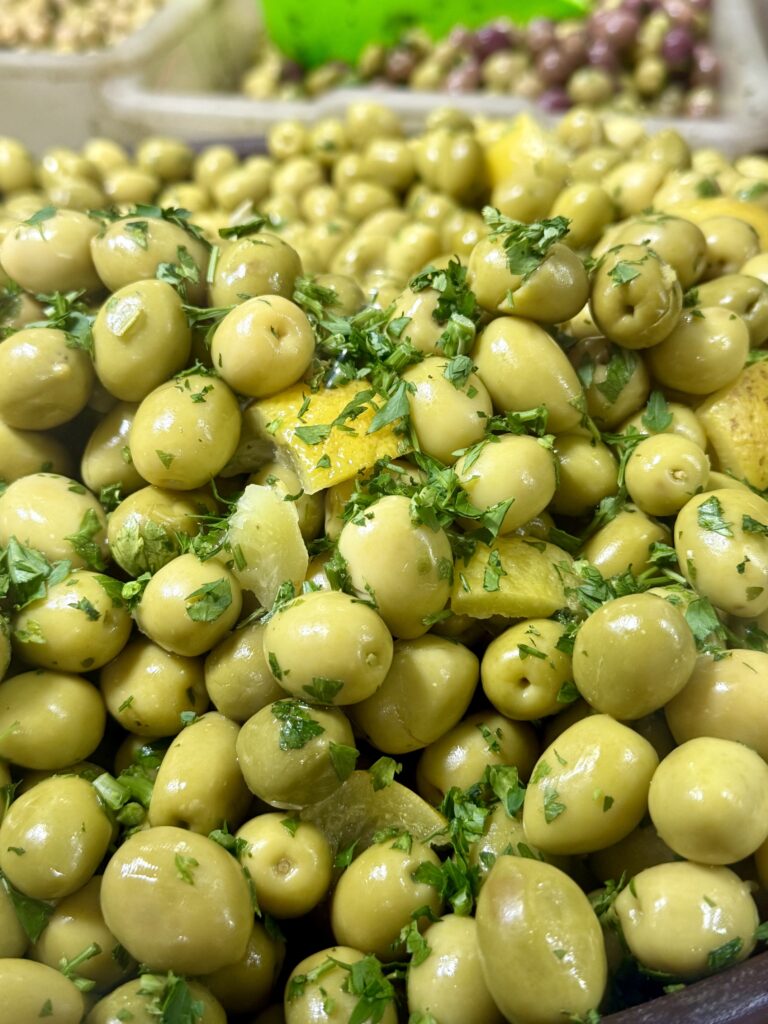
Explore the Flavors of Morocco: Top Foods to Try
Stepping into Moroccan cuisine is like starting a fun journey for your senses. You will find aromatic spices, such as cumin, ginger, cinnamon, and saffron. They bring flavor to both traditional dishes and street food. The mix of these flavors creates a good experience for your taste buds.
Whether you enjoy a slow-cooked tagine, taste the delicate pastilla, or have a hearty bowl of harira, Moroccan cuisine offers unique and unforgettable moments.
1. Tagine – The Quintessential Moroccan Dish
The tagine is often seen as the perfect Moroccan dish. It shows off the country’s rich cooking traditions. More than just food, it is a way of life. It brings families and communities together to enjoy meals.
A tagine is a slow-cooked stew made in a special clay cooking pot with a pointy lid. This lid helps steam to move around, mixing flavors into the food. Common ingredients are tender meats like lamb, chicken, or beef, along with an array of vegetables, dried fruits, and spices.
The slow cooking makes the meat and vegetables very soft. They soak up the delicious spice flavors, creating a blend of tastes that truly captures traditional Moroccan cuisine.
2. Couscous – A Celebratory Staple
Couscous is an important part of life in Morocco. It’s not just food; it represents celebration, tradition, and enjoying meals with family and friends. Made from small steamed pieces of durum wheat, couscous can take on many different flavors.
People often eat it with vegetable tagine, tasty meats, or a mix of spices. The texture of couscous adds a nice contrast to the deep flavors in Moroccan cuisine.
You can enjoy couscous on Fridays, which is its traditional day, or any day you like. This dish shows the simple yet rich heritage of Moroccan cooking.
3. Pastilla – A Sweet and Savory Delight
Pastilla, or bastilla, is a special dish in Moroccan cuisine. It brings together sweet and savory flavors in a tasty way. This beautiful pie has many thin layers of warqa pastry that hold a rich and flavorful filling.
Traditionally, it is made with pigeon meat but can also include chicken or seafood. It often contains toasted almonds, eggs, and a mix of spices like saffron and cinnamon. To finish it off, a sprinkle of powdered sugar adds sweetness to balance the savory taste.
With its many layers, different flavors, and beautiful look, pastilla shows the skill and flair of Moroccan cooking.
4. Harira – A Rich and Nourishing Soup
Harira is a tasty soup made with tomatoes and has deep roots in Moroccan culture. It is important during the holy month of Ramadan. People enjoy it to break their fast at sunset, bringing them comfort and nourishment.
This delicious soup has a mix of lentils, chickpeas, tomatoes, and vermicelli noodles. Everything cooks together in a flavorful broth made special with spices like ginger, turmeric, and cinnamon. The rich mix of beans, vegetables, and spices makes harira a healthy and filling meal.
You can enjoy harira during Ramadan or any other time of the year. It shows the true spirit of Moroccan hospitality and warmth.
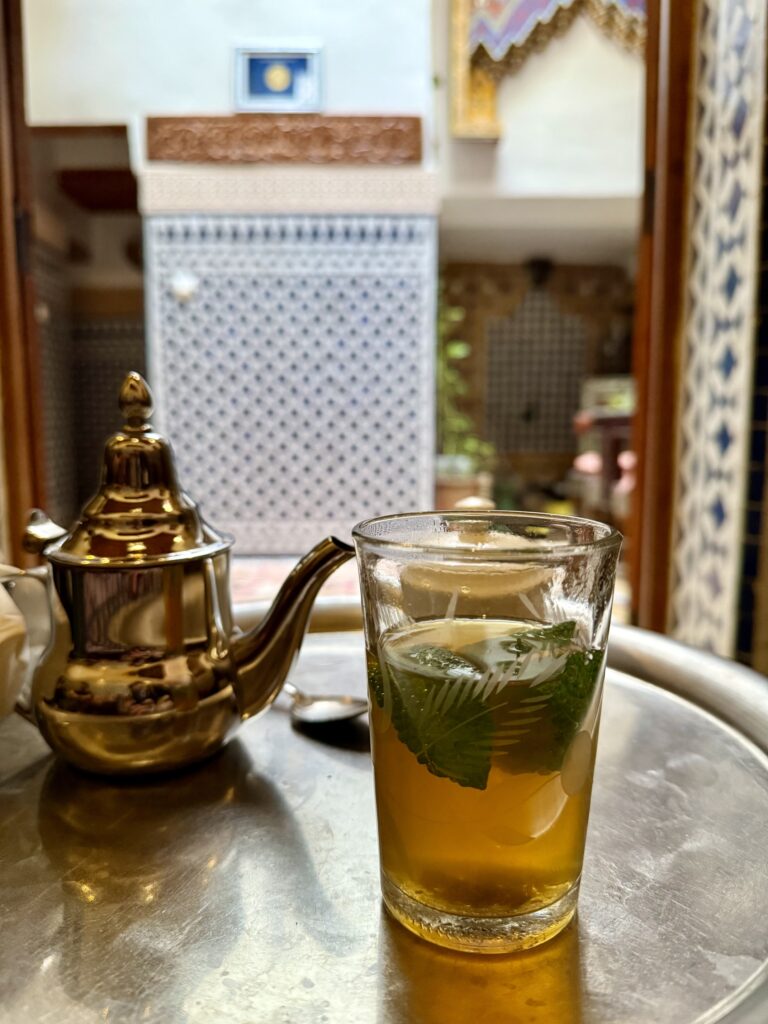
5. Mint Tea – More Than Just a Beverage
In Morocco, mint tea is not just a drink—it’s a sign of friendliness, hospitality, and culture. People enjoy this tea as part of their daily lives. You can drink it anytime, whether you are welcoming guests or relaxing with friends.
Mint tea is made with green tea leaves, fresh mint, sugar, and hot water. It is served in small glasses. The tea is poured from a height to create a light froth on top.
Here are some reasons why mint tea is important in Moroccan culture:
- Symbol of Hospitality: Offering mint tea to guests shows respect and welcomes them in Moroccan culture.
- Social Ritual: Sharing a pot of mint tea helps people connect, talk, and deepen their relationships.
- Refreshing Delight: Mint tea is great for warm weather. It is energizing and quenches thirst, especially at sunset.
6. Mechoui – Succulent Slow-Roasted Lamb
Mechoui is a true feast for your senses and shows how Moroccans are great at slow roasting. This special dish includes a whole lamb, seasoned with fragrant spices, and cooked perfectly in a traditional underground oven.
Mechoui comes from the Atlas Mountains and is loved all over Morocco. You often find it served at special events, weddings, and family gatherings. The slow roasting makes the meat tender and allows it to easily fall off the bone. The smoky flavor and aromatic spices make it delicious.
When people share a mechoui meal, it creates a sense of community. It represents generosity, hospitality, and the joy of coming together to enjoy the rich flavors of Moroccan cooking.
7. Zaalouk – A Flavorful Eggplant Dip
Zaalouk is a tasty and colorful eggplant dip. It shows how simple and delicious Moroccan cuisine can be. This dip is made with roasted eggplant, tomatoes, garlic, and a mix of spicy flavors. Zaalouk is a special dish that wakes up your taste buds.
Traditionally, the eggplant is cooked over an open flame. This gives it a smoky flavor that goes well with the sweet tomatoes. A good amount of olive oil makes it richer. Spices like cumin, paprika, and coriander add warmth and depth to the dip.
Zaalouk is usually served as part of a mezze spread or as a side dish with grilled meats and bread. It truly showcases the vibrant flavors and fresh ingredients of Moroccan cuisine.
8. Bissara – A Hearty Fava Bean Soup
Bissara is a simple yet tasty fava bean soup that is very important in Moroccan cooking. This warm and filling soup is a common breakfast in many Moroccan homes. It helps to start the day with good energy and warmth.
Bissara is made with dried fava beans, olive oil, cumin, and a bit of spicy chili pepper. It is a basic dish but has a rich taste that shows how clever Moroccan cooking can be. Before serving, the soup usually gets a drizzle of extra olive oil and a dash of cumin. This step boosts its smell and earthy flavors.
You can enjoy bissara for breakfast or even as a light lunch. It is a great example of the tasty and comforting foods that have been shared through many years in Moroccan kitchens.
9. Kefta – Moroccan Meatballs
Kefta are tasty Moroccan meatballs that can be used in many dishes. They are made from ground meat, usually lamb or beef, and are flavored with spices like cumin, paprika, and the special spice blend called ras el hanout.
Ras el hanout means “head of the shop” in Arabic. This spice mix can be different from one seller to another, giving kefta a special taste. You can grill, pan-fry, or bake these flavorful meatballs. They are commonly served in tagines, sandwiches, or on a mezze platter.
You can enjoy kefta in a traditional tagine or in a street food sandwich. They truly celebrate the strong flavors and creative cooking that make Moroccan cuisine special.
10. Camel Burger – Exactly What it Sounds Like
For adventurous eaters who want to try something different, Morocco has camel meat, which is a special dish in many areas of the country. While camel meat is not as popular as chicken or lamb, you can find it in some restaurants and food stalls, especially in Marrakech.
Camel meat is leaner than beef and has a unique flavor. A favorite way to enjoy it is in a camel burger. The meat is usually seasoned with spices like saffron, cumin, and paprika, and then grilled just right.
Eating a camel burger is a great way to explore Moroccan cuisine. It lets you experience exciting flavors and try exotic ingredients, stepping outside of your usual food choices.
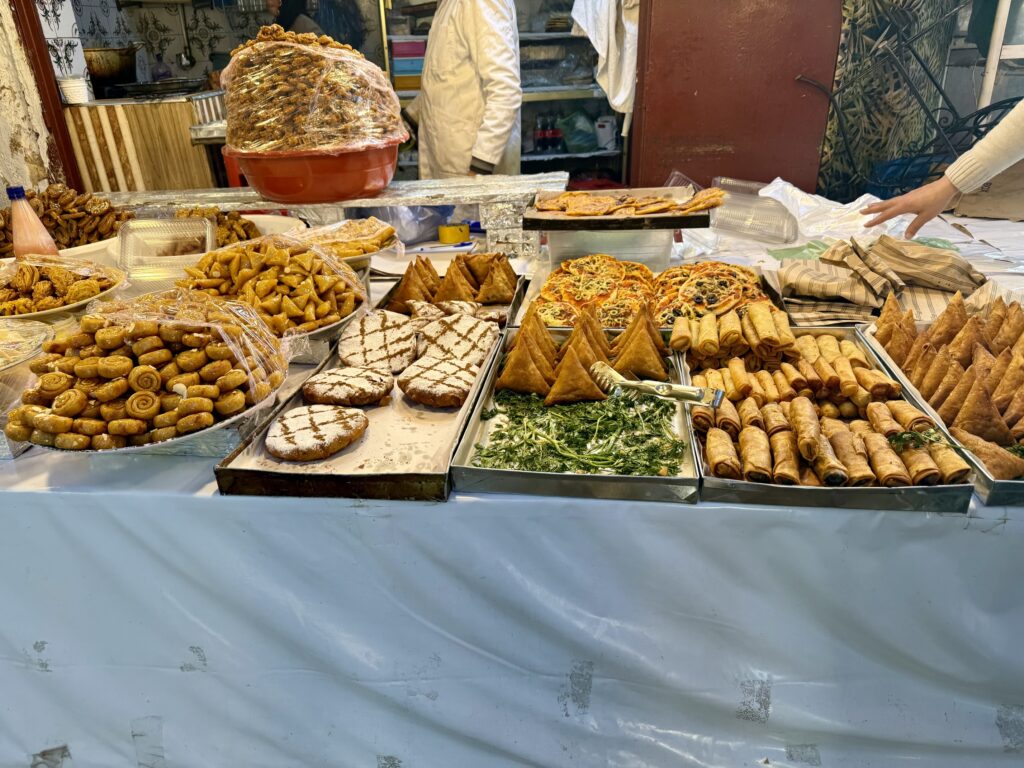
Moroccan Street Foods You Must Not Miss
Exploring the busy streets of Morocco’s medinas is a treat for your senses. The street food in this area is something you should definitely try. You can find tasty snacks and sweet treats that show the rich food culture of the country.
If you want crispy maakouda, soft sfenj, or juicy brochettes, you will find plenty of choices in Morocco. The street food offers many tasty and budget-friendly options, making it great for a quick meal or a yummy snack.
1. Maakouda – Tasty Potato Fritters
Maakouda are crispy potato fritters that many people love. They are a popular street food in Morocco. You can find them from street vendors and small restaurants. These fritters give you a tasty bite of Moroccan flavors.
Maakouda is made with mashed potatoes mixed with spices like cumin, paprika, and fresh herbs. They are deep-fried until they are a golden-brown and crispy. This process makes a great mix of crunchy outside and tender inside.
Here are some reasons to try maakouda:
- Affordable Indulgence: Maakouda is an easy-to-find snack that won’t break the bank.
- Spice Combinations: The spices in maakouda can change, giving you flavors that range from mild to spicy.
- Dipping Delights: You often enjoy maakouda with harissa paste, a spicy chili sauce, that adds more flavor to the fritters.
2. Sfenj – Moroccan Doughnuts
Sfenj are light and fluffy Moroccan doughnuts. They are a tasty treat that can satisfy your sweet tooth. These doughnuts are made with a simple dough that is fried until golden brown. They are usually topped with sugar for extra sweetness.
Unlike heavier doughnuts from Western countries, sfenj has a light and airy feel, with a slight chewiness. The dough often has a hint of orange blossom water, which adds a light floral scent that goes well with the sweetness.
You can enjoy sfenj for breakfast with a cup of mint tea or treat yourself to them in the afternoon. They show the simple and delightful pleasures found in Moroccan street food.
3. Brochettes – Grilled Meats on Skewers
Brochettes are skewers of grilled meats and are a popular street food in Morocco. They offer a tasty and easy meal when you’re on the go. You can find them at many street stalls and small places. Brochettes show how simple and delicious Moroccan grilling can be.
These tasty treats are made with tender pieces of lamb, beef, or chicken. They are marinated in good spices and then grilled over charcoal. This cooking method gives them a juicy and smoky flavor that makes the meat so savory.
You can enjoy brochettes in a crusty bread roll or wrapped in warm flatbread. They are a great and tasty way to enjoy the rich flavors of Moroccan street food.
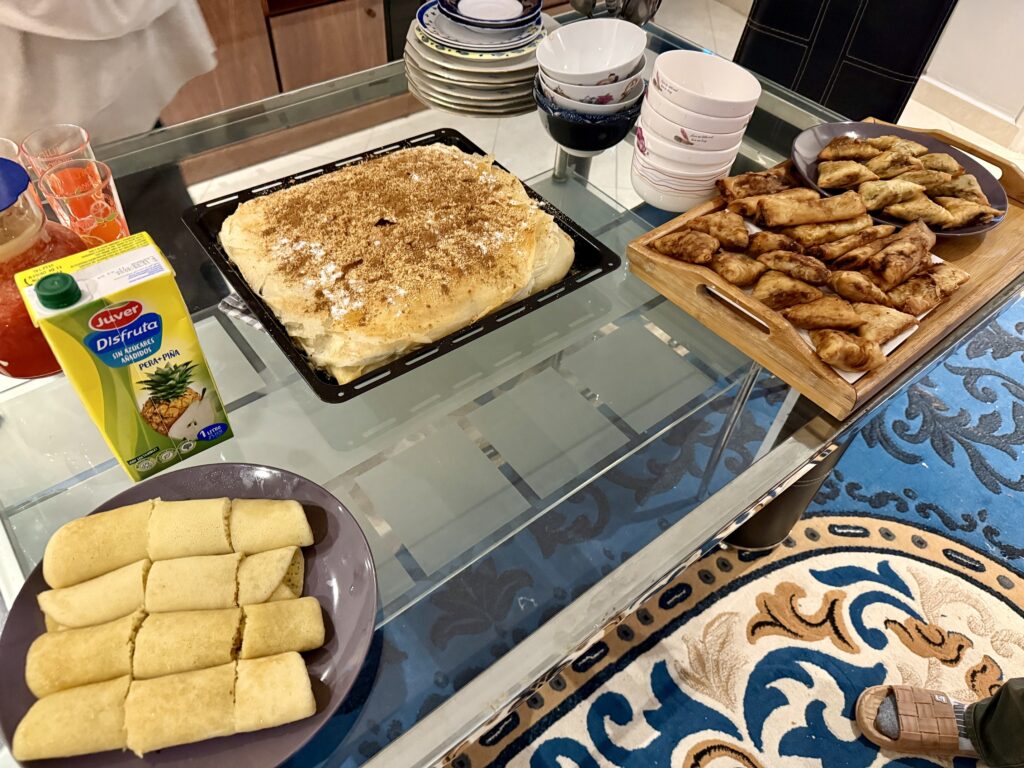
Indulge in Moroccan Desserts
Moroccan desserts show how much the country enjoys sweet treats. They have light pastries and rich cookies. These sweets often have lovely flavors like honey, orange blossom water, and almonds. This mix of tastes really excites your taste buds.
If you want something sweet after a tasty meal or a nice snack for the afternoon, Moroccan desserts have many delicious choices for you to try.
1. Chebakia – Honey-coated Sesame Cookies
Chebakia is a tasty Moroccan cookie made with sesame and covered in honey. This treat is especially loved during the holy month of Ramadan. Making Chebakia takes time and skill, showing the hard work of Moroccan bakers.
The dough is rolled, folded, and deep-fried until it turns golden brown and crispy. After frying, these cookies soak in a sweet honey syrup. This syrup is often flavored with orange blossom water or rose water, which gives it a light floral scent.
Chebakia is topped with sesame seeds, which adds to the chewy and nutty taste. Its mix of crunchy, chewy, sweet, and nutty flavors makes it a unique treat for Ramadan.
2. Cornes de Gazelle – Crescent-shaped Pastries
Cornes de gazelle are delicate crescent-shaped pastries from Morocco. These tasty treats are filled with almond paste and have a lovely scent of orange blossom water. They taste just as good as they smell.
The dough is rolled out and formed into crescents. It’s then filled with ground almonds, sugar, and orange blossom water. After that, they are baked until they turn golden brown and sprinkled with powdered sugar. This makes them look beautiful and tasty.
Usually, people enjoy cornes de gazelle with mint tea or coffee. They are a special treat that shows off the wonderful flavors and skills of Moroccan bakers.
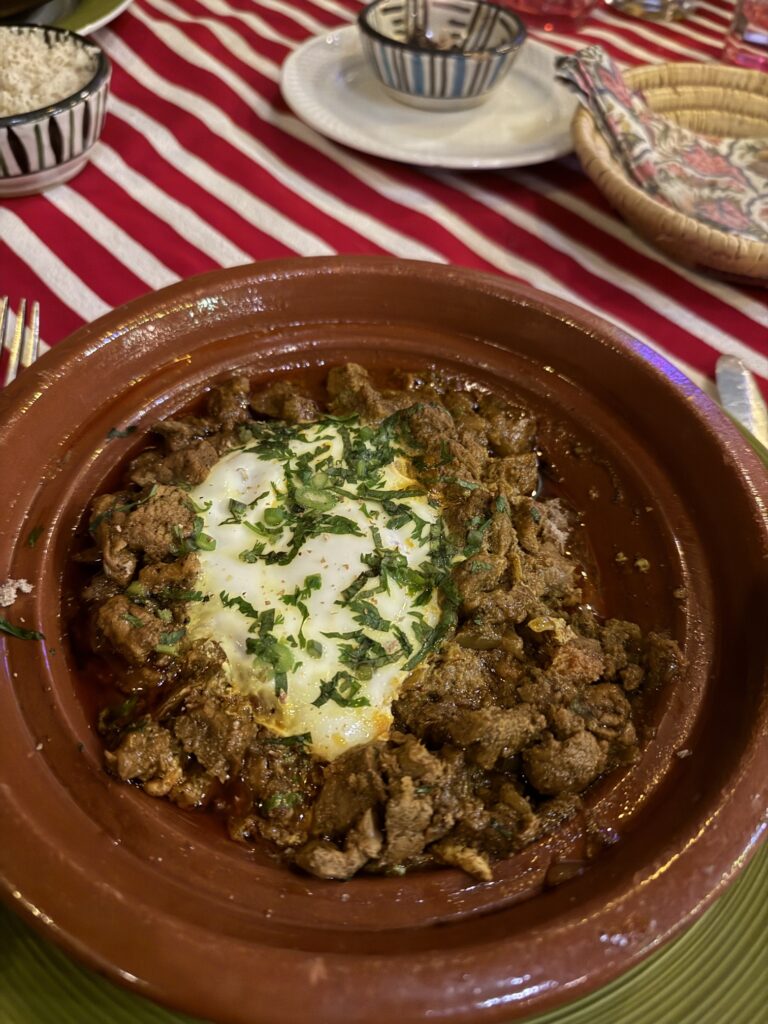
Conclusion
Experiencing the rich and lively food culture of Morocco goes beyond just eating. It is a journey into history and tradition. Each dish, like the fragrant tagines and the sweet pastilla, shares a story of the wonderful flavors that make Moroccan cuisine special. Make sure to try street foods like Maakouda and Sfenj. Don’t forget to enjoy tasty desserts such as Chebakia and Cornes de Gazelle. Whether you love food or like to try new things, going to Morocco will excite your taste buds and have you wanting more. So, pack your bags, start this food adventure, and enjoy the amazing tastes of Morocco! Use this list to plan what food to try in Morocco!
Planning a visit to Morocco? Check out my complete travel guide!
Frequently Asked Questions
What is Morocco’s National Dish?
Many people think tagines are the national dish, but couscous deserves that title. This flexible dish can be served with an array of vegetables, meats, or just with spices. It truly captures the essence of Moroccan cuisine.
What Are the Best Places to Eat in Morocco?
Marrakech and Fez are great places for food lovers. But you can find amazing dining all over Morocco. Look for local restaurants in the medinas. Try the street food stalls, and think about dining at a riad for some home-cooked meals.
What Ingredients Are Common in Moroccan Food?
Moroccan cuisine is full of flavor. This is because it uses strong spices like cumin, turmeric, saffron, ginger, paprika, and cinnamon. Olives are often added to dishes, and preserved lemons give a special Moroccan taste.
Where Are the Best Moroccan Food Tours?
Marrakech is famous for its food tours. These tours usually take you through the lively medina. You can taste street food and discover traditional ingredients and cooking methods.
What Are the Best Places to Stay in Morocco for Foodies?
Food lovers should think about staying in riads that serve home-cooked meals. This is especially true in great food cities like Casablanca, Fes, and Marrakech. Many boutique hotels have fantastic restaurants that focus on Moroccan cuisine.
Recent Posts
Related Posts
Explore Yosemite National Park: A Nature Lover’s Paradise
Key Highlights Next, let’s dive into what makes Yosemite National Park an unmatched treasure of the United…
Local Favorites: What Food to Eat in California
Key Highlights Introduction California, also called the golden state, is a great place for people who love…
Discover the 20 Best Places to Visit in California Now
Key Highlights Introduction California is a place that has something for everyone. You can find natural beauty…

